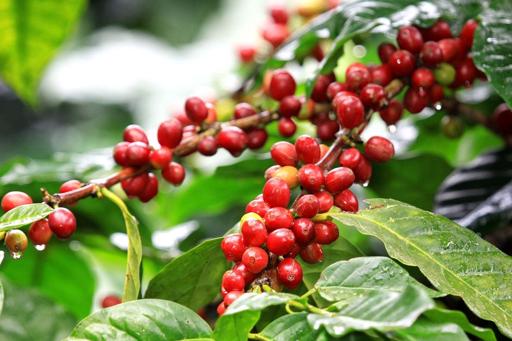Coffee
Coffea spp.
Also known as: Arabica Coffee, Robusta Coffee

Growing Information
Growth Habit: Tree
Climate Requirements: Prefers tropical climates with temperatures between 18–24°C and high humidity.
Soil Requirements: Well-drained, fertile soils with a pH of 6.0–6.5.
Water Requirements: Requires regular rainfall or irrigation, but well-drained soils are essential.
Planting Instructions: Typically grown from seeds or cuttings, with spacing of 2–3 meters between plants.
Harvesting Information: Harvested once the coffee cherries turn red, typically 9–11 months after flowering.
Characteristics & Benefits
Plant Characteristics: Coffee is a tropical evergreen shrub or small tree known for its seeds (coffee beans), which are used to produce the beverage coffee.
Nutrient Content: Coffee beans contain caffeine, antioxidants, and several vitamins and minerals.
Health Benefits: Coffee is known for its stimulating effect due to caffeine, and it may also have antioxidant properties.
Yield Information: Average yield is 1–2 tons of coffee beans per hectare.
Uses & Distribution
Culinary Uses: Used to brew coffee, which is a popular beverage worldwide. The beans can be roasted and ground.
Industrial Uses: Coffee beans are processed into beverages, and coffee grounds are used for various products, including cosmetics and fertilizers.
Native Range: Native to tropical Africa.
Current Distribution: Grown in tropical regions around the world, with major producers including Brazil, Vietnam, and Colombia.
Pest & Disease Management
Common Pests: Coffee borer beetle, aphids, and whiteflies.
Diseases: Coffee leaf rust, coffee berry disease, and root rot.
IPM Practices: Use of resistant varieties, proper spacing, and integrated pest management strategies.
Market Value: $300.00
Research & References
Studies and Articles: Research on improving coffee crop resilience to climate change and pests.
Bibliography: Coffee: Cultivation, Processing, and Uses, 2022.
Comments
Add CommentNo comments yet. Be the first to comment!